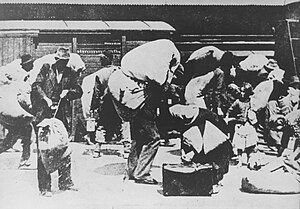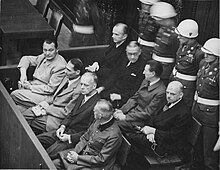Consequences of Nazism
This article has multiple issues. Please help improve it or discuss these issues on the talk page. (Learn how and when to remove these template messages)
|
| World War II |
|---|
| Navigation |
|
|
| Timelines of World War II |
|---|
| Chronological |
| Prelude |
| By topic |
| By theatre |
Nazism and the acts of Nazi Germany affected many countries, communities, and people before, during and after World War II. Nazi Germany's attempt to exterminate several groups viewed as subhuman by Nazi ideology was eventually stopped by the combined efforts of the wartime Allies headed by the United Kingdom, the Soviet Union, and the United States.
Jewish people

Of the world's 18 million Jews in 1939, more than a third were murdered in the Holocaust.[1][2] Of the three million Jews in Poland, the heartland of European Jewish culture, fewer than 60,000 survived. Most of the remaining Jews in Eastern and Central Europe became refugees, unable or unwilling to return to countries that became Soviet puppet states or countries that had betrayed them to the Nazis.
Poland
The Nazis intended to destroy the Polish nation completely. In 1941, the Nazi leadership decided that Poland was to be fully cleared of ethnic Poles within 10 to 20 years and settled by German colonists to further their policy of Lebensraum.[3] From the beginning of the occupation, Germany's policy was to plunder and exploit Polish territory, turning it into a giant concentration camp for Poles who were to be exterminated as "Untermenschen".[3] The policy of plunder and exploitation inflicted material losses to Polish industry, agriculture, infrastructure and cultural landmarks, with the cost of the destruction by Germans alone estimated at €525 billion or $640 billion.[4] Remaining Polish industry was mostly destroyed, or transported to Russia by Soviet forces after the war.
The official Polish government report of war losses prepared in 1947 reported 6,028,000 war victims out of a population of 27,007,000 ethnic Poles and Jews alone. For political reasons, the report excluded the losses to the Soviet Union and the losses among Polish citizens of Ukrainian and Belarusian origin.
Poland's eastern border was significantly moved westwards to the
See also
- Nazi crimes against the Polish nation
- Expulsion of Poles by Germany
- Generalplan Ost
- German AB-Aktion in Poland
- The Holocaust in Poland
- Occupation of Poland (1939–1945)
- Operation Tannenberg
- Intelligenzaktion
- Chronicles of Terror
Central Europe
As a consequence of the war and Soviet occupation, Central European countries found themselves under the "Soviet sphere of influence" (as agreed upon at the Yalta Conference). Immediately following the war, Soviet style socialist governments were established in all of these countries and any forms of western style democracy that existed before the war were abolished. As a result of the Warsaw Pact not participating in the Marshall Plan, as well as industrial infrastructure being taken by the Soviets, economic recovery was slowed significantly.
Soviet Union
About 26 million Soviet citizens perished as a result of the
Close to 60% of the European war dead were from the Soviet Union. Military losses of 10.6 million include 7.6 million killed or missing in action and 2.6 million
To the north, the Germans reached
Of the 5.7 million Soviet prisoners of war captured by the Germans, more than 3.5 million had died while in German captivity by the end of the war.[13] On 11 February 1945, at the conclusion of the Yalta Conference, the United States and United Kingdom signed a Repatriation Agreement with the USSR.[14] The interpretation of this Agreement resulted in the forcible repatriation of all Soviets regardless of their wishes.[15] Millions of Soviet POWs and forced laborers transported to Germany are believed to have been treated as traitors, cowards and deserters on their return to the USSR (see Order No. 270).[16][17] Statistical data from Soviet archives, that became available after Perestroika, attest that the overall increase of the Gulag population was minimal during 1945–46[18] and only 272,867 of repatriated Soviet POWs and civilians (out of 4,199,488) were imprisoned.[19]
Belarus
Some recent estimates raise the number of Belarusians who perished in War to "3 million 650 thousand people, unlike the former 2.2 million. In other words, not every fourth inhabitant but about 40% of the pre-war Belarusian population perished (considering the present-day borders of Belarus)."[21] This compares to 15% of Poland's post war borders and 19% of Ukrainian population in post war border and comparing to 2% of Czechoslovakian population that perished in post war borders.
Ukraine
Estimates of population losses in Ukraine range from 7 million to 11 million. More than 700 cities and towns and 28,000 villages were destroyed.[22]
See also
- Forced settlements in the Soviet Union
- Generalplan Ost
- Hunger Plan
- Occupation of Belarus by Nazi Germany
- Operation Keelhaul
- World War II casualties
Yugoslavia

It is estimated that 1,700,000 people were killed during
Western Europe
Britain and France, two of the victors, were exhausted and bankrupted by the war, and Britain lost its superpower status.[23] With Germany and Japan in ruins as well, the world was left with two dominant powers, the United States and the Soviet Union. Economic and political reality in Western Europe would soon force the dismantling of the European colonial empires, especially in Africa and Asia.
One of the most important political consequences of the Nazi experience in Western Europe was the establishment of new political alliances which eventually became the
The Communists emerged from the war sharing the vast prestige of the victorious Soviet armed forces, and for a while it looked as though they might take power in France, Italy and Greece. The West quickly acted to prevent this from happening, hence the Cold War.
Greece
In Greece, the
The bitterest and longest-lasting legacy of the German occupation was the social upheaval it wrought. The old political elites were sidelined, and the
Germany

More than 8 million Germans, including almost 2 million civilians, died during World War II (see World War II casualties). After the end of the war in Europe additional casualties were incurred during the Allied occupation and also during the population expulsions that followed.
After the war, the German people were often viewed with contempt because they were blamed by other Europeans for Nazi crimes. Germans visiting abroad, particularly in the 1950s and 1960s, attracted insults from locals, and from foreigners who may have lost their families or friends in the atrocities. Today in Europe and worldwide (particularly in countries that fought against the Axis), Germans may be scorned by elderly people who were alive to experience the atrocities committed by Nazi Germans during World War II. This resulted in a feeling of controversy for many Germans, causing numerous discussions and rows among scholars and politicians in Post-War West Germany (for example, the "Historikerstreit" [historians' argument] in the 1980s) and after Reunification. Here, the discussion was mainly about the role that the unified Germany should play in the world and in Europe. Bernard Schlink's novel The Reader concerns how post-war Germans dealt with the issue.
Following World War II, the Allies embarked on a program of denazification, but as the Cold War intensified these efforts were curtailed in the west.
Germany itself and the German economy were devastated, with great parts of most major cities destroyed by the bombings of the Allied forces,
The expulsions of Germans from the lost areas in the east (see also
After a short time, the Allies broke over ideological problems (Communism versus Capitalism), and thus both sides established their own spheres of influence, creating a previously non-existent division in Germany between East and West (although the division largely followed the borders of states which had existed in Germany before Bismarck's unification less than 100 years before).
A constitution for
The first free elections in West Germany were held in 1949, which were won by the Christian Democratic Union of Germany (CDU, conservatives) by a slight margin. Konrad Adenauer, a member of the CDU, was the first Bundeskanzler (Chancellor) of West Germany.
Both German states introduced, in 1948, their own money, colloquially called West-Mark and Ost-Mark (Western
Foreign troops still remain in Germany today, for example
The West German economy was by the mid-1950s rebuilt thanks to the abandonment in mid-1947 of some of the last vestiges of the
The dismantling of factories in the western zones, for further transport to the Soviet Union as reparations, was in time halted as frictions grew between East and West. Limits were placed on permitted levels of German production in order to prevent resurgence of German militarism, part of which included severely restricting German steel production and affected the rest of the German economy very negatively (see "
The Allies confiscated intellectual property of great value, all German patents, both in Germany and abroad, and used them to strengthen their own industrial competitiveness by licensing them to Allied companies.
For several years following the surrender German nutritional levels were very low, resulting in very high mortality rates. Throughout all of 1945 the U.S. forces of occupation ensured that no international aid reached ethnic Germans.
As agreed by the Allies at the
The post-war hostility shown to the German people is exemplified in the fate of the War children, sired by German soldiers with women from the local population in nations such as Norway where the children and their mothers after the war had to endure many years of abuse. In the case of Denmark the hostility felt towards all things German also showed itself in the treatment of German refugees during the years 1945 to 1949. During 1945 alone 7000 German children under the age of 5 died as a result of being denied sufficient food and denied medical attention by Danish doctors who were afraid that rendering aid to the children of the former enemy would be seen as an unpatriotic act. Many children died of easily treatable ailments. As a consequence "more German refugees died in Danish camps, "than Danes did during the entire war.""[36][37][38][39]
During the Cold War, it was difficult for West Germans to visit East German relatives and friends and impossible vice versa. For East Germans, especially after the building of the Berlin Wall on 13 August 1961 and until Hungary opened up its border to the West in the late 1980s, thus allowing hundreds of thousands of vacationing East Germans to flee into Western Europe, it was only possible to get to West Germany by illegally fleeing across heavily fortified and guarded border areas.
44 years after the end of World War II, the Berlin Wall fell on 9 November 1989. The East and West parts of Germany were reunited on 3 October 1990.
Economic and social divisions between East and West Germany continue to play a major role in politics and society in Germany at present. It is likely the contrast between the generally well-off and economically diverse West and the weaker, heavy-industry reliant East will continue at least into the foreseeable future.
See also
- Berlin Wall
- Cold War
- German reunification
- Germany
- History of Germany since 1945
- Marshall Plan
- Ostpolitik
World politics
The war led to the discrediting and dissolution of the League of Nations and it also led to the founding of the United Nations (UN) on 24 October 1945. Like its predecessor, the UN was established in order to help prevent the outbreak of another world wars and contain or stop smaller conflicts. The principles which are enshrined in the Charter of the United Nations are a testament to the world's attitudes after the defeat of Nazi Germany. Geopolitically, the United States and the Soviet Union emerged as the two new dominant rivaling superpowers. Consequently, two blocks around the US and the USSR formed. The rivalry caused the Cold War and led to several proxy conflicts. Briefly, before its final decline as a superpower, Great Britain also counted to the "Big Three", a term used to refer to the world's major global powers (the US, USSR and Britain at the time).
International law

The effect the Nazis had on present-day international law was substantial. The
Racism
After the world viewed the Nazi death camps, many Western people began to outwardly oppose ideas of racial superiority. Liberal anti-racism became a staple of many Western governments, with openly racist publications looked down upon. The move towards tolerance of different cultures in Western societies has continued to develop until the present day. Since the collapse of Nazi Germany, Western populations have been wary of racial political parties and they have actively discouraged white ethnocentrism, fearing the recurrence of a catastrophe which would be similar to the purges which were carried out in Germany by the Nazis. On the other hand, it can be argued that the conception of multiculturalism has gained importance as one of the pillars of contemporary Western society because of the same reaction. The actions of the Nazis caused an increase in anti-German sentiment.
Military
German military doctrine under the Nazi regime, characterized with some controversy as
As Nazi Germany faced severe defeat after the
References
- ISBN 0-88033-995-0. subsection by Richard Dominic Wiggers, The United States and the Refusal to Feed German Civilians after World War II
Footnotes
- ^ "History of the Holocaust – An Introduction". Jewish Virtual Library. 19 April 1943. Retrieved 13 November 2011.
- ^ Luke Harding in Moscow (5 June 2007). "Pipeline workers find mass grave of Jews killed by Nazis". The Guardian. UK. Retrieved 13 November 2011.
- ^ Volker R. Berghahn"Germans and Poles 1871–1945" in "Germany and Eastern Europe: Cultural Identities and Cultural Differences", Rodopi 1999
- ^ Poles Vote to Seek War Reparations, Deutsche Welle, 11 September 2004
- ^ Concise statistical year-book of Poland, Polish Ministry of Information. London June 1941 P.9 & 10
- ^ The Expulsion of Germans from Poland, Revisited Archived 12 June 2007 at the Wayback Machine, H-Net Review
- ^ A. Dirk Moses, Genocide and Settler Society: Frontier Violence and Stolen Indigenous Children in Australian History, Google Print, p.260
- ^ Tadeusz Piotrowski, Poland's Holocaust: Ethnic Strife, Collaboration with Occupying Forces and Genocide in the Second Republic, 1918–1947, Google Print, p.22
- ^ "Leaders mourn Soviet wartime dead". BBC News. 9 May 2005. Retrieved 13 November 2011.
- OCLC 54860366.
- ^ Zvi Gitelman, History, Memory and Politics: The Holocaust in the Soviet Union
- ^ "Europe-Asia Studies: Soviet deaths in the Great Patriotic War: a note - World War II". 5 December 2004. Archived from the original on 5 December 2004. Retrieved 1 January 2020.
- ^ "Soviet Prisoners of War: Forgotten Nazi Victims of World War II". HistoryNet.com. Archived from the original on 30 March 2008. Retrieved 13 November 2011.
- ^ The United States and Forced Repatriation of Soviet Citizens, 1944–47 by Mark Elliott Political Science Quarterly, Vol. 88, No. 2 (Jun., 1973), pp. 253–275
- ^ "Forced Repatriation to the Soviet Union: The Secret Betrayal". Hillsdale College. Archived from the original on 7 February 2012. Retrieved 13 November 2011.
- ^ "The warlords: Joseph Stalin". Channel 4. Retrieved 13 November 2011.
- ^ Remembrance (Zeithain Memorial Grove) Archived 13 October 2007 at the Wayback Machine
- ^ Getty, Rittersporn, Zemskov. "Victims of the Soviet Penal System in the Pre-war Years". Archived from the original on 11 June 2008.
{{cite web}}: CS1 maint: multiple names: authors list (link) - ^ "Репатриация перемещённых советских граждан // Виктор Земсков". Scepsis.ru. Retrieved 13 November 2011.
- ^ "Khatyn WWII Memorial in Belarus". The Virtual Guide to Belarus. 22 March 1943. Retrieved 13 November 2011.
- ^ "Partisan Resistance in Belarus during World War II". The Virtual Guide to Belarus. Retrieved 13 November 2011.
- ^ "Ukraine :: World War II and its aftermath". Encyclopædia Britannica. Retrieved 13 November 2011.
- ^ "BBC - History - British History in depth: Britain, the Commonwealth and the End of Empire".
- ^ Tim Kane, PhD., Global U.S. Troop Deployment, 1950–2003 Archived 28 February 2007 at the Wayback Machine, The Heritage Foundation 27 October 2004
- ^ a b Ray Salvatore Jennings "The Road Ahead: Lessons in Nation Building from Japan, Germany, and Afghanistan for Postwar Iraq Archived 14 May 2008 at the Wayback Machine May 2003, Peaceworks No. 49 pg.15
- ^ "Pas de Pagaille!". Time. 28 July 1947.
- ^ Amos Yoder, "The Ruhr Authority and the German Problem", The Review of Politics, Vol. 17, No. 3 (Jul., 1955), pp. 345–358
- ^ C. Lester Walker "Secrets By The Thousands". Harper's Magazine. October 1946.
- ^ Norman M. Naimark The Russians in Germany pg. 206. (Naimark refers to Gimbels book)
- ^ The $10 billion compares to the U.S. annual GDP of $258 billion in 1948.
- ^ The $10 billion compares to the total Marshall plan expenditure (1948–1952) of $13 billion, of which Germany received $1.4 billion (partly as loans).
- ^ ISBN 0-88033-995-0. subsection by Richard Dominic Wiggers, "The United States and the Refusal to Feed German Civilians after World War II"
- ^ S. P. MacKenzie "The Treatment of Prisoners of War in World War II" The Journal of Modern History, Vol. 66, No. 3. (Sep., 1994), pp. 487–520.
- ^ Jonas Tjersland, Tyske soldater brukt som mineryddere, VG Nett, 8 April 2006
- ISBN 0-674-78405-7pp. 132,133
- Copenhagen Post, 15 April 2005
- ^ Manfred Ertel, Denmark's Myths Shattered: A Legacy of Dead German Children, Der Spiegel, 16 May 2005
- ^ Andrew Osborn, Documentary forces Danes to confront past, The Observer, 9 February 2003
- ^ Danish Study Says German Children Abused, Deutsche Welle, 10 April 2005
- ^ "Convention on the Prevention and Punishment of the Crime of Genocide, New York, 9 December 1948". Archived from the original on 16 November 2012. Retrieved 7 December 2012.
- ^ "International Humanitarian Law - Fourth 1949 Geneva Convention". Retrieved 7 December 2012.
